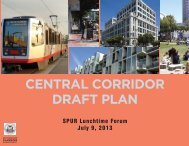energizing innovation in integrated project delivery final report - SPUR
energizing innovation in integrated project delivery final report - SPUR
energizing innovation in integrated project delivery final report - SPUR
You also want an ePaper? Increase the reach of your titles
YUMPU automatically turns print PDFs into web optimized ePapers that Google loves.
• How well does the new technology meet the firm’s strategic technical goal?<br />
• How well does the new technology fit <strong>in</strong> with such goals as new market<strong>in</strong>g <strong>in</strong> core<br />
bus<strong>in</strong>ess, strengthen<strong>in</strong>g of core bus<strong>in</strong>ess, licens<strong>in</strong>g of technology, f<strong>in</strong>d<strong>in</strong>g new areas<br />
for manufactur<strong>in</strong>g, and enhanc<strong>in</strong>g the firm’s image as a technology leader?<br />
• How well does the new technology relate to current technologies?<br />
• How <strong>in</strong>novative is the new technology?<br />
• What is the current market size of exist<strong>in</strong>g or similar technology?<br />
• What will the growth of the market be over the next five years?<br />
• What are the group’s abilities based on past performance?<br />
• How clear is the proposed new technology development process?<br />
In addition to measures to assess the potential for an <strong><strong>in</strong>novation</strong> to be successful, possible metrics<br />
for assess<strong>in</strong>g the outcome of an <strong><strong>in</strong>novation</strong> are identified <strong>in</strong> the literature. The follow<strong>in</strong>g metrics<br />
for assess<strong>in</strong>g the success and impacts of <strong><strong>in</strong>novation</strong> <strong>in</strong> the construction <strong>in</strong>dustry have been<br />
suggested (Egbu 2001; Turrell 2006; Tucker 2004):<br />
• The percentage of profit/sale derived from the <strong><strong>in</strong>novation</strong><br />
• The number of new products/solutions <strong>in</strong>troduced (rate)<br />
• The number of <strong>in</strong>novative ideas generated<br />
• The number of man hours put <strong>in</strong>to an <strong><strong>in</strong>novation</strong><br />
• Time to market<br />
• The level of client satisfaction<br />
• The average failure rate<br />
• L<strong>in</strong>kage of <strong><strong>in</strong>novation</strong> plann<strong>in</strong>g to overall bus<strong>in</strong>ess strategy<br />
• The extent to which the workforce is <strong>in</strong>volved with <strong><strong>in</strong>novation</strong><br />
• Revenue growth of new products<br />
• Patent submissions<br />
• Idea and submission flow through and organization<br />
• Percent of current year sales due to new products released <strong>in</strong> the past N-years<br />
Dikmen et al. (2005) identify lead<strong>in</strong>g <strong>in</strong>dicators and trail<strong>in</strong>g <strong>in</strong>dicators of <strong><strong>in</strong>novation</strong>. The<br />
lead<strong>in</strong>g <strong>in</strong>dicators <strong>in</strong>clude: objectives of the firm, required and available resources, and<br />
government <strong>in</strong>centives. Trail<strong>in</strong>g <strong>in</strong>dicators <strong>in</strong>clude: technological advancements, improvements<br />
<strong>in</strong> schedule, budget, and quality, client satisfaction, monetary ga<strong>in</strong>s, social benefits, and<br />
<strong>in</strong>creased effectiveness of the firm.<br />
The Construction Industry Institute (CII) and National Science Foundation (NSF) identified five<br />
factors that need to be present <strong>in</strong> order for change (<strong><strong>in</strong>novation</strong>) to occur <strong>in</strong> eng<strong>in</strong>eer<strong>in</strong>g and<br />
construction through the implementation of new technologies and transfer of <strong>in</strong>formation<br />
(CII/NSF 1997). These five factors are:<br />
1. Change must have value to the owner. Most changes happen when demanded by the<br />
<strong>project</strong> owner. The owner, who allocates and controls fund<strong>in</strong>g, must see f<strong>in</strong>ancial<br />
value <strong>in</strong> any change.<br />
23




